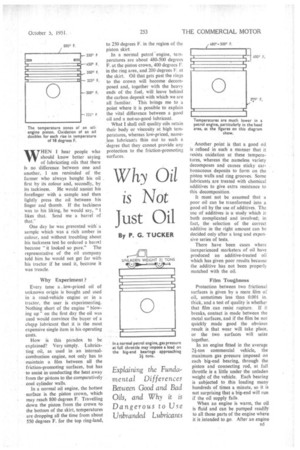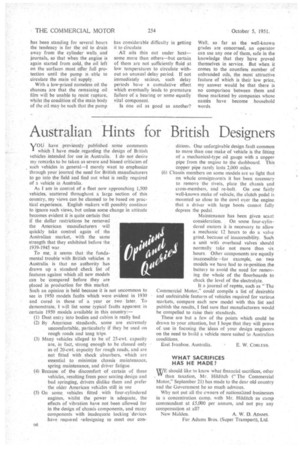Why Oil is Not Just Oil
Page 45

Page 46

If you've noticed an error in this article please click here to report it so we can fix it.
Explaining the Fundamental Differences Between Good and Bad Oils, and Why it is Dangerous to Use Unbranded Lubricants
By P. G. TUCKER HEN I hear people who should know better saying of lubricating oils that there is no 'difference between one and another, I am reminded of the farmer who always bobght his oil first by its colour and, secondly, by its tackiness. He would anoint his forefinger with a sample and then lightly press the oil between his finger and thumb. If the tackiness was to his liking, he would say, " I likes that. Send me a barrel of that."'
One day he was presented with a sample which was a rich amber in colour, and without troubling about his tackiness test he ordered a barrsl because "it looked so pure." The representative of the oil company told him he would not get far with his tractor if he used it, because it was treacle.
Why Experiment ?
Every time a , low-priced oil of unknown origin is bought and used in a road-vehicle engine or in a tractor, the user is experimenting. Nothing short of the engine "blowing up" on the first day the oil was used would convince the buyer of a cheap lubricant that it is the most expensive single item in his operating costs.
How is this paradox to be explained? Very simply. Lubricating oil, as used in an internalcombustion engine, not only has to maintain a film between all the friction-promoting surfaces, but has to assist in conducting the heat away from the pistons to the comparatively cool cylinder walls.
In a normal oil engine, the hottest surface is the piston crown, which may reach 800 degrees F. Travelling down the piston from the crown to the bottom of the skirt, temperatures are dropping all the time from about 550 degrees F. for the top ring-land, to 250 degrees F. in the region of the piston skirt.
In a normal petrol 'engine, temperatures are about 480-500 degrees F. at the piston crown, 400 degrees P. in the ring area, and 200 degrees F. at the skirt. Oil that gets past the rings to the crown will become decomposed and, together with the heavy ends of the fuel, will leave behind the carbon deposit with which we are all familiar. This brings me to a point where it is possible to explain the vital difference between a good oil and a not:-so-good lubricant.
What I shall call quality oils retain their body or viscosity at high temperatures, whereas low-priced, nameJess lubricants thin out to such a degree that they cannot provide any protection to the friction-promoting surfaces. " Another point is that a good oil is refined in such a manner that it resists oxidation at these temperatures, whereas the nameless variety decomposes and causes sticky car. bonaceous deposits to form on the piston walls and ring grooves. Some lubricants are treated with chemical additives to give extra resistance to this decomposition.
It must not be assumed that a poor oil can be transformed into a good oil by the use of additives. The use of additives is a study which is both complicated and involved; in fact, the selection of the correct additive in the right amount can be decided only after a long and expensive series of tests.
There have been cases where inexperienced marketers of oil have produced an additive-treated oil which has given poor results because the additive has not been properly matched with the oil.
Film Toughness Protection between two frictional surfaces is given by a mere film of oil, sometimes less than 0.001 in. thick, and a test of quality is whether that film can resist rupture. If it breaks, contact is made between the metal surfaces, and if the film be not quickly made good the obvious result is that wear will take place, or the two surfaces will seize together.
In an engine fitted in the average 2i-ton commercial vehicle, the
maximum gas pressure imposed on each big-end bearing, through the piston and connecting rod, at full throttle is a little under the unladen
weight of the vehicle. Each bearing is subjected to this loading many hundreds of times a minute, so it is
not surprising that a big-end will run if the oil supply fails When an engine is warm, the oil is fluid and can be pumped readily
to all those parts of the engine where it is intended to go. After an engine has been standing for several hours the tendency is for the oil to drain away from the cylinder walls, and journals, so that when the engine is again started from cotd, the oil left on the surfaces must offer full protection until the pump is able to circulate the main oil supply.
With a low-priced nameless oil the chances are that the remaining oil film will be unable tQ resist rupture, whilst the condition of the main body of the oil may be such that the pump
has considerable difficulty in getting it to circulate • All oils thin out under heat— some more than others—but certain of them are not sufficiently fluid at. low temperatures to circulate without an unusual delay period. If not immediately serious, such delay periods have a cumulative effect which eventually leads to premature failure of a bearing or some equally vital component.
Is one oil as good as another? Well, so far as the well-known grades are concerned, an operator can use any one of them, safe in the knowledge that they have proved themselves in service. But when it comes to the countless number of unbranded oils, the most attractive feature of which is their low price, my answer would be that there is no comparison between them and those marketed by companies whose 'iambs have become household words.
































































































